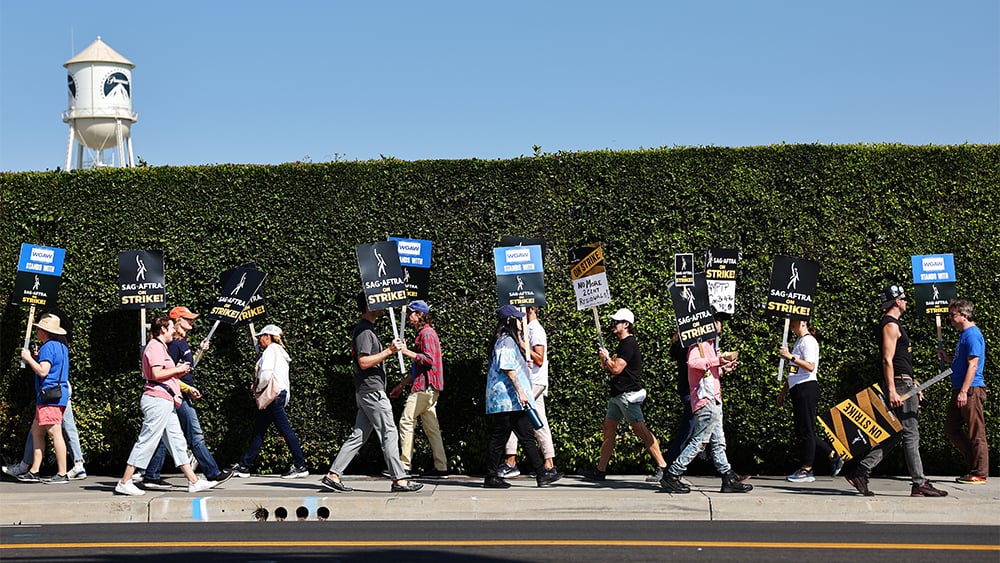Duncan Crabtree-Ireland expected to be back at SAG-AFTRA headquarters Thursday, continuing to negotiate a new contract with the heads of four major studios.
But on Wednesday evening, he got a call from the Alliance of Motion Picture and Television Producers informing him that the talks were off.
“I was taken completely by surprise,” said Crabtree-Ireland, the chief negotiator for the actors union. “Today we were planning to have an all-day session.”
The AMPTP announced Wednesday night that the talks have been suspended, saying the differences between the sides is “too great” and that “conversations are no longer moving us in a productive direction.”
It was yet another setback in a year that has been full of them, and it dashed the optimism that followed the end of the 148-day writers strike. It is not clear how long it will take for talks to resume, but insiders are privately predicting that it could be weeks or even months. In the meantime, the industry will continue to sit idle, exacerbating the damage from a historic year of labor strife.
The talks with SAG-AFTRA resumed on Oct. 2 for the first time since July, and from the outside it appeared that the two sides were making some progress. But it was a different story in the negotiating room.
According to Crabtree-Ireland, the studios have flatly rejected the union’s demand for a 2% share of streaming revenue. So on Wednesday, they brought in a new proposal, under which actors would be paid a set rate per subscriber from each of the major streaming platforms.
Love Film & TV?
Get your daily dose of everything happening in music, film and TV in Australia and abroad.
Among other disagreements, the two sides do not see eye-to-eye on the cost of the proposal. SAG-AFTRA believes it would cost about $500 million per year, or 57 cents per subscriber. The AMPTP, which negotiates on behalf of the studios, pegged the cost at more than $800 million, or about $1.08 per subscriber.
Either way, the CEOs believe it is economically “irrational” and not a basis for further talks. Management sources noted that in some regions outside the U.S., the average revenue per user metric does not reach the $1 threshold. The AMPTP has offered SAG-AFTRA a viewership-based bonus that would be patterned off the agreement reached last month with the WGA. But for SAG-AFTRA, that won’t fly.
“Writers and actors are compensated in a totally different way,” Crabtree-Ireland said Thursday. “And so, the philosophy of it is fine, but the structure of the residual doesn’t work for our members.”
The WGA got a 50% residual bonus for shows watched by 20% of a streaming platform’s domestic subscribers within the first 90 days of release. But that applies only to made-for-streaming shows, and most will not hit that threshold. SAG-AFTRA wants its members to compensated for all programs that appear on streaming, including theatrical films and pre-existing shows licensed from broadcast and cable.
“It is a very modest sharing of the massive money that they generate from our members work,” Crabtree-Ireland said. “It amounts to less than a postage stamp per year per subscriber. Is that really so much to ask?”
Ted Sarandos, the co-CEO of Netflix, appeared on stage at the Bloomberg Screentime conference on Thursday morning. He called the union’s subscriber-based fee a “levy” on subscribers.
“It just felt like a bridge too far to add this deep into the negotiation,” he said.
The studios and the union remain at odds on several other items, including artificial intelligence and increases in minimums to keep pace with inflation.
The CEOs are particularly focused on the role of Fran Drescher, the union’s president, who has taken an active part in talks over the last two weeks. The onetime star of “The Nanny,” Drescher has been credited with coming up with the initial concept of the union’s revenue sharing proposal.
Studio sources said that Drescher has been adamant that the negotiation is an opportunity to “change the world” for actors. These sources believe she has spent more time making speeches and is unwilling to engage in productive talks.
The studio side believes that when the WGA returned to bargaining in late September, its leaders were serious about making a deal, and that SAG-AFTRA is not there yet.
The AMPTP published its most recent proposal on Wednesday night, in hopes that rank-and-file members will read it and see it as a reasonable basis for further negotiation. The AMPTP made a similar move when talks stalled with the WGA in mid-August, which prompted backlash from members who saw it as an attempt to circumvent leadership.
Crabtree-Ireland said that the union remains ready and willing to negotiate. Donna Langley, NBCUniversal chief content officer who with Sarandos are among the four senior studio executives who have met with SAG-AFTRA in eight bargaining sessions, told the Screentime conference on Wednesday night that executives were committed to getting to the finish line. But two hours after she spoke, the AMPTP issued the lengthy statement that surprised the SAG-AFTRA team.
“We’ve been spending time with the actors and we want to spend as much time as it takes until we can reach a resolution and get the industry back on its feet and back to work,” Langley said.
On Thursday morning, Crabtree-Ireland was resolute.
“They’re the ones who walked away from the table — not us,” he said.
Cynthia Littleton contributed to this story.
From Variety US































